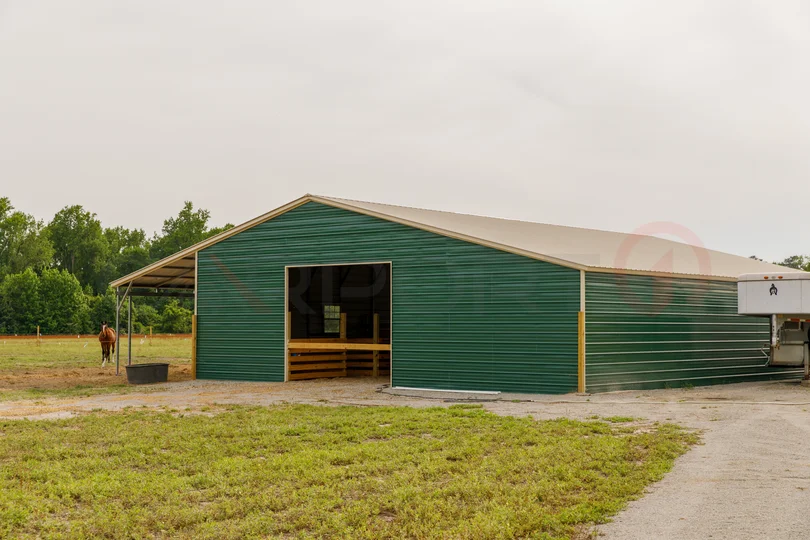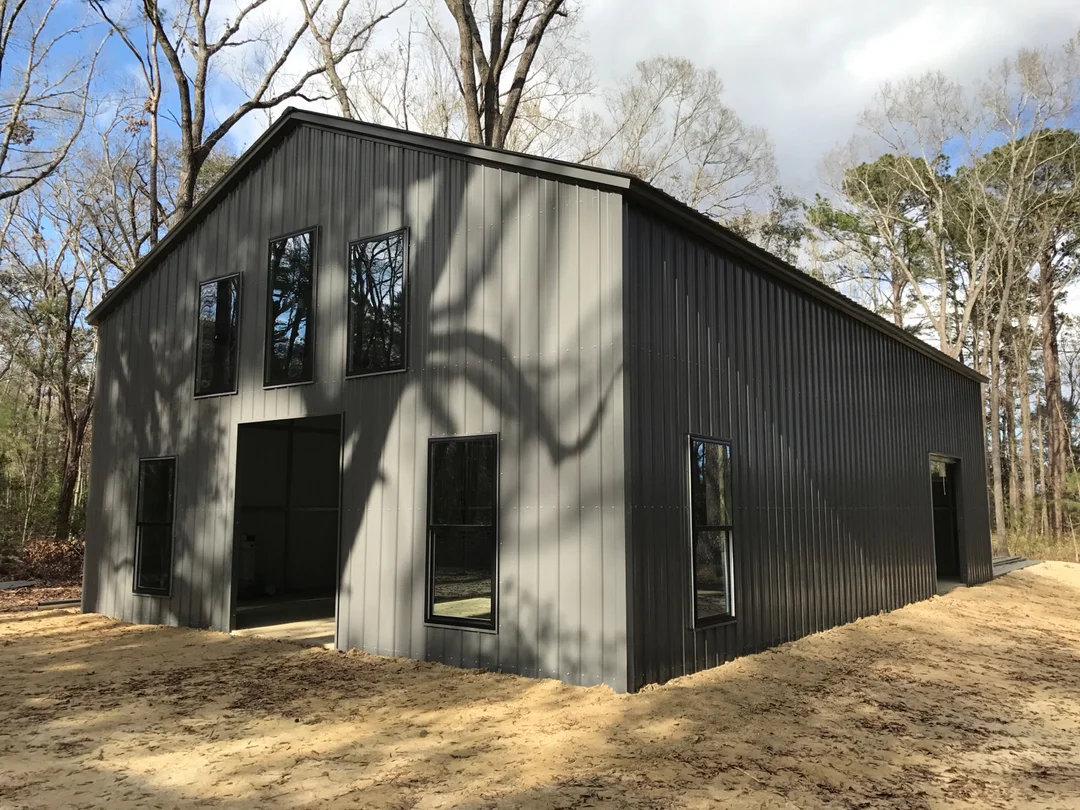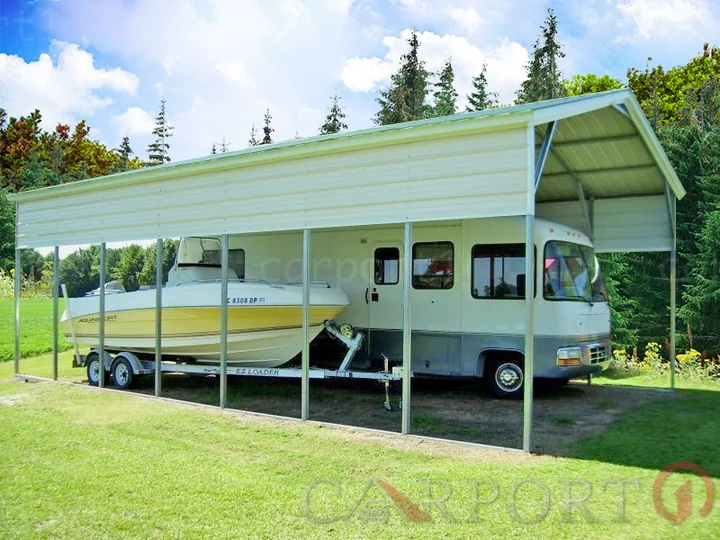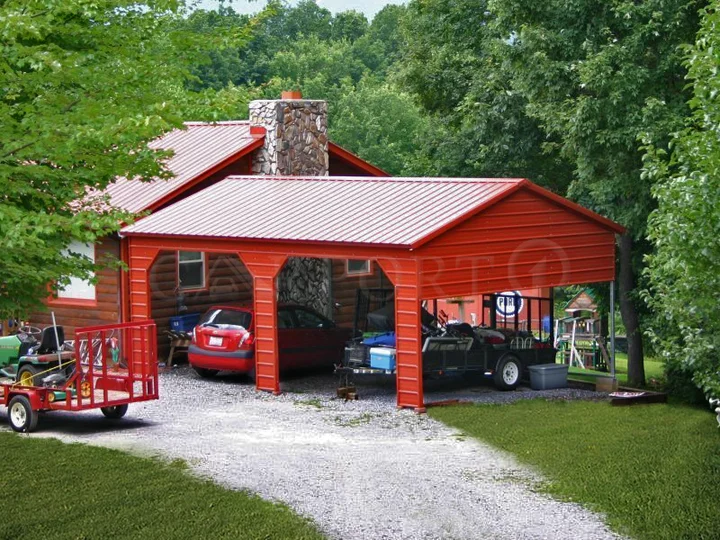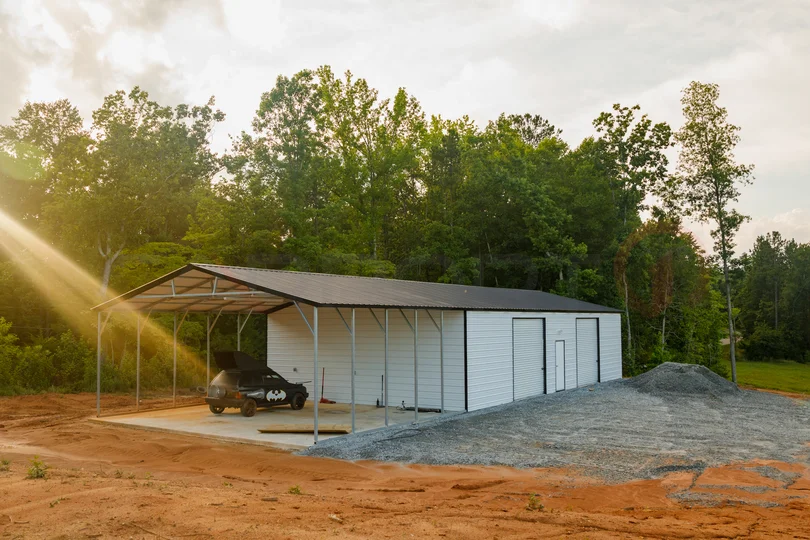Metal RV Carports Buying and Installation Guide
What to Consider when buying a Metal Carport
What type of vehicle are you looking to store?
The initial step in determining what type of carport to buy is to ascertain what type of RV (Recreational Vehicle) you are looking to store. The size of RV depends on its type. A typical RV includes motorhomes, campervans, caravans, fifth-wheel trailers, popup campers and truck campers, with size ranging from a single-deck to double-deck.
A small carport is optimum for single-deck RV and a large carport will accommodate multiple RVs and other vehicles. You can choose to store your RV along with a boat too inside a single carport. The size of the carport you buy entirely depends on the size and number of your vehicle.
Where will you install your new metal carport?
You must determine where you would want to install your new metal carport, as the ground needs a bigger and open space for our staff to move freely during installation. The perimeter of your metal carport also determines how much space you would need to fit your RV.
For most motorhomes, you need to measure at least 12FT wide space for a carport. However, this can be quite small and uncomfortable to access. The other factors determining the carport is the surface type (Concrete) and ground level.
Does it need to be certified?
Many state building regulations in the United States require your metal carports be certified after installation. It is essential to ascertain if the newly built carport can withstand a specific amount of wind, rain, and snow, for the public safety.
Local construction and building inspector will visit the site and review your new metal carport, size, ground surface, and the building plan to make sure the structure complies with their guidelines and regulations.
How’s the weather?
Most first-timers buyers fail to notice the local climate before building a new carport. The climate of your place determines what kind of carport you would need to buy. If your vicinity receives rain throughout the year, you would need a carport with vertical roof and gutters so the rainwater can slide off easily. The areas which receive more snow, wind or sunlight may need different types of carport and roof styling.
How about style?
The custom styling of your carport, roof, panel, and walls should fit your requirement. You can choose from a regular, boxed eave or vertical roof styling depending on the local climate. The size, material, and sides may depend on the type and number of vehicles you wish to fit.
Roof Style
The roof of your metal carport largely depends on the climate of your area. However, the styling may entirely depend on your taste. Finding roof styling is easy with us. We offer multiple choices of styling and material. If you couldn’t find the styling of your taste, you can choose to entirely customize the roof as per your need.
VERTICAL ROOF STYLE – BEST
Vertical roof style is an A-Frame roof design. It works best for the climate with heavy snowfall or rainfall. The vertical panel allows snow and water residue to slide off easily off the roof. In vertical styling, the roof intersects with the side of the carport allowing residue to pass off easily. Hence, it requires less or none cleaning.
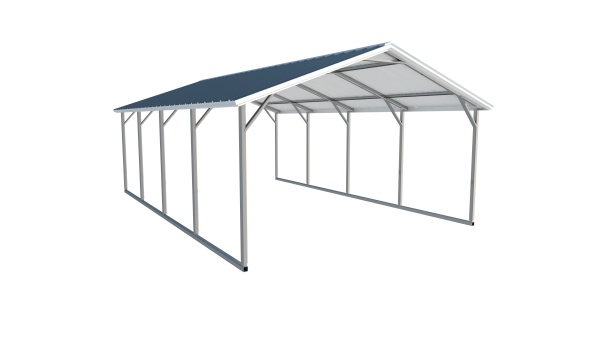
Vertical Roof Style RV Cover
BOXED EAVE STYLE – BETTER
Boxed Eave style is known for its roof panel which lies horizontally to the side of the carport. It is an A-frame roof style which goes horizontally towards the ground. This is a more affordable than vertical roof styling and works best in the climate with heavy wind.

Boxed Eave Roof Style RV Cover
REGULAR – GOOD
Regular style roof is the most economical choice for the carports. It is lighter compared to Boxed Eave and Vertical styles. The corrugated ridges run from end to end. This roof style works great in the area with less wind and rain. This is perfect for protecting your RV from direct sunlight.

Regular Roof Style RV Cover
Choosing the Right Size
Choosing the right size of the carport is easier when you have all the details in hand. The size of carport mainly depends on the availability of area, number of RVs and their sizes. Right size guarantees best carports of your need.
Width sizing Chart
The metal carport comes in variable sizes. However, you can choose your own width for your carport. While ordering one, you must be sure that the custom carport is big enough to fit your RVs and vehicles.
Although the standard carport width sizes are prefixed, you can choose your own width even with the difference of just an inch. The smallest carport you can order is with the width sizing of 12FT. Other larger sizes are 20, 22, 24. The largest metal carport size may go up to 40FT, however, you may not need a carport of that size. Most larger carports can fit multiple RVs, RVs and boats or vehicles.
Please consult with our representative to find the right size of the carport.
Length
The length of your car carports depends on the number of vehicles you own and their size. To best decide the length, you can ascertain the vehicles you own and possible width size of the carport you require. Sometimes, the carport is used for more than just storing vehicles, like; parking family bikes, family recreation, storing equipment and pieces of machinery etc.
If you are looking to store a small RV, 21FT works just fine. The 41 FT works perfectly for storing two cars, RV or truck. You can also choose your own length for a metal carport.
Side Height
The height of the carport is measured from sides instead of from the tip of the roof to the ground. The height is used to measure the lowest point your vehicle can clear while entering or exiting the carport. You’ll want to build a metal carport that offers just the right amount of height in order to maximize the protection, accessibility, and stability of the structure.
The height should be enough to accommodate the solar panels or satellite attached to the roof of your RV.
You can customize and choose a preferred height for your carport. If you have planned to enclose your carport in the future, it is better to determine the right height right now so your structure is tall enough to install the garage door.
Steel Gauge Framing
What’s the difference between 14 gauge and 12 gauge framing?
Many new metal carport owners may have this question. For your information, a 12 gauge framing is thicker than a 14 gauge framing.
Gauge stands for, “the thickness, size, or capacity of something, especially as a standard measure, in particular:” Hence, the thicker the framing the more strength and value it adds to the overall property.
12 gauge Vs 14 Gauge
14 Gauge Framing
A 14 gauge steel frame measuring 2 ½” x 2 ½” in diameter. 14 gauge framing tends to be economical than 12 gauge framing and has a lower tensile strength.
The 14-gauge steel is an economical choice and useful for regular carports or for the carports located in mild climate areas.
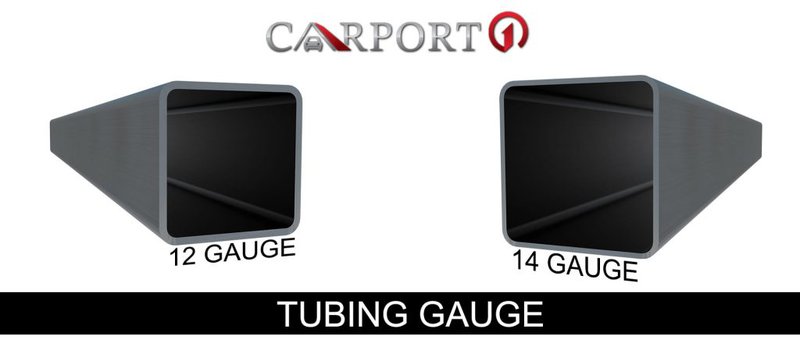
12 Gauge Framing
A 12-gauge steel frame measures 2 ¼” x 2 ¼” in diameter
The 12 gauge framing is more useful for the carports in the areas where there are frequent and heavy snow and wind. It provides more tensile so the chances of breakage are none.
Certification Considerations
Certified vs. Non-certified buildings
Most states require metal carports to be inspected and certified after installation for public safety. The certification simply proves that the building has been designed taking in to account the ratings for wind and snow load. It becomes necessary in the areas which receive heavy snow and wind.
Some states don’t require any kind of certification or inspection simple because they do not have to worry about heavy snow or wind.
We do not offer any warranty on the certified buildings. A certification only means that the structure is made to specifications and has been certified.
To get the building inspected, you will require the blueprint of the building for the inspector to review. In such a case, we’ll provide you with the necessary documentation.
Note: Please ensure, while preparing the base for the carport the ground is level and the concrete or asphalt slab is wide enough to support the carport.
Additional Options
Additional options stand for the additional features or attributes that you add to your metal carport. The additional features help for certain situations or customization for a particular need.
Gable ends
Gable ends are the end wall of a building on the side which is topped by a gable. It comes handy in providing additional framing or support to the carport roof, making the entire structure stronger and aesthetically appealing.
It offers the finishing touch to the entire structure. It also helps to protect the vehicle from the weather in certain cases. An additional steel frame in the triangular shape is added to the roof to provide structural support.
You can choose to add gable ends after the installation of the carport, however, we recommend that you add it while building the structure to save cost.
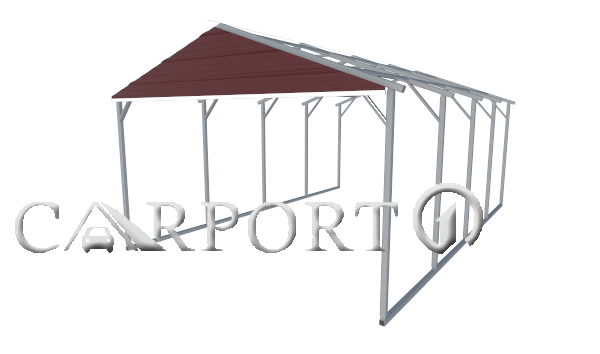
Gable Ends on RV Cover from Carport1
Panels
A panel is a flat steel structure added to the sides, walls or frames to offer additional support and strength the overall structure. It also acts as shelving or walls provided to the carport to add additional protection for the vehicles from the weather.
Side panels are useful in the areas with heavy wind. It can be added after the installation as well. The carports with the height of 10ft or more should consider adding side panels for much needed additional protection to the overall structure.
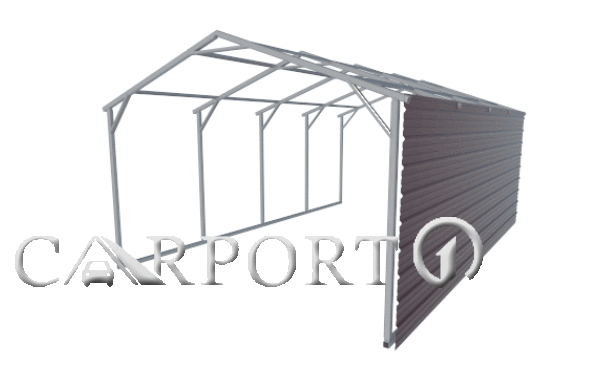
J-trim
J-trims are decorative trim pieces installed to the edges of panels to offer additional safety and to give the entire structure an aesthetic appeal. J-trim installation adds additional protection to the carports for homes with young children.
Bows and trusses
Bows and trusses offer additional support to the roof by adding assistance and stability. This is more useful in the areas with heavy snow. The addition of bows and trusses to the roof structure and sides of the building extends their bearing capacity.
It makes the structure tougher and also fits well inside the roof. It doesn’t affect the aesthetic appeal of the structure. Our steel carports with a width size of 24 FT will include a bow, and all carports wider than 24 FT will have a truss.
You can already add bows and trusses while installing the carport, or also choose to add them to the structure after the installation.
Anchors
Anchors provide additional support to the frames or beams of the metal carport during or after the installation. The metal anchors are inserted into the concrete slabs, poured asphalt or to solid ground to hold the structure.
Our installation staff will add the anchors to the structure during installation. In order to do that, you must first prepare the concrete base or level ground for them to work on.
Colors
We offer 15 different shades for you to choose as the palette of your new carport. The colors range from:
Black, Burgundy, Cardinal, Red, Clay, Earth, Brown, EverGreen, Merlot, Pebble Beige, Pewter, Gray, Quaker Gray, SandStone, Slate, Blue, Tan, White, etc.

Installation / Site Prep
Installation and Site Prep
Before the metal carport can be delivered and installed, we require you to have the site prepared beforehand. The preparation may include getting all the required permissions, utilities, and open space.
Do level the ground or concrete surface for our staff to start installing the structure. In case you haven’t cleared the ground, our experts will have to reschedule the installation to a later date, and it may incur an additional charge to you.
Our crew requires a minimum of 3FT of additional space around the perimeter of leveled ground to bring in the equipment for the installation. If you haven’t finished preparing the ground or may need professional help, we can recommend a concrete contractor to you.
Site Preparation Checklist
Make sure the ground is level, this is essential if you want to get your building certified. The newly built structure cannot be more than 3 inches off level from either front/back or left/right. If the site isn’t ready during the installation, our experts will level the site at an additional charge.
Ensure that you have cleared the area of debris or tools so our installation team can access the site easily.
Soil Foundation
- Carports can be installed on a soil foundation too. However, if you’re choosing the soil as the foundation you must prepare the site by removing any kind of vegetation, grass or debris.
- You must level the area. For this, you can either use a commercial tamper or drive over the area multiple times to get the loose soil pounded and compact. You can also use a concrete roller to get the job done.
- Once the ground is ready, keep the area clear so our experts can come in with heavy equipment and get the job done at as quickly as possible.
Concrete Pad
- If you wish to use a concrete pad as the foundation, you must have the area ready on time, concrete fully cured and settled, before our experts can start installing the metal structure.
- Ensure that the concrete pad meets the state or city’s guidelines, and get it checked by an expert so there aren’t any issues during installation or the certification process.
Overview of the delivery and installation process
Once you have selected the carport of your choice, all we need to do is visit your place and complete the installation.
We’ll contact you and schedule a delivery date. On the scheduled day, our installation staff will arrive with trucks and tools to install the structure.
If you wish to have your carport certified, please do let us know before the installation so we can get the blueprint ready for you to provide to the inspector.
Pricing
Price Range
The price of a metal carport depends on its size, type, roof style and made. Our metal carport prices typically range from $1,095 to $4,195. Customizations may cost additional.
Size
We build different sizes of carports for both residential and commercial usage. You can buy any standardly-sized carport at a fixed price or provide your own custom measurements. In case of customization, we’ll first ascertain the cost and offer you a reasonable quote.
Some of the regular carport sizes you can choose from;
| Regular | Boxed Eave | Vertical |
|---|---|---|
| 12×21 | 12×21 | 12×21 |
| 12×26 | 12×26 | 12×26 |
| 12×31 | 12×31 | 12×31 |
| 12×36 | 12×36 | 12×36 |
| 12×41 | 12×41 | 12×41 |
| 18×21 | 18×21 | 18×21 |
| 18×26 | 18×26 | 18×26 |
| 18×31 | 18×31 | 18×31 |
| 18×36 | 18×36 | 18×36 |
| 18×41 | 18×41 | 18×41 |
| 20×21 | 20×21 | 20×21 |
| 20×26 | 20×26 | 20×26 |
| 20×31 | 20×31 | 20×31 |
| 20×36 | 20×36 | 20×36 |
| 20×41 | 20×41 | 20×41 |
| 22×21 | 22×21 | 22×21 |
| 22×26 | 22×26 | 22×26 |
| 22×31 | 22×31 | 22×31 |
| 22×36 | 22×36 | 22×36 |
| 22×41 | 22×41 | 22×41 |
| 24×21 | 24×21 | 24×21 |
| 24×26 | 24×26 | 24×26 |
| 24×31 | 24×31 | 24×31 |
| 24×36 | 24×36 | 24×36 |
| 24×41 | 24×41 | 24×41 |
Certification
The carport owners need to get their carport or structure certified by the state/local authority or the Building and Construction Inspector. For the certification process, you will require the blueprint of the structure along with the usage of a certified steel frame. You can get the blueprint for free. The price of the carport depends on your choice of size, material, roof style and add-ups for the structure.
A certified structure for a carport has a frame that is built of extra-strength 12-gauge galvanized steel. 12-gauge is thicker than a 14-gauge steel frame and comes with an additional warranty. 14-gauge framing works excellently in the areas with less snow or wind. A 12-gauge frame is expensive than a 14-gauge frame, so choose wisely.
A Certified building should have a minimum wind rating starting at 80 mph and a snow-load rating starting at 20 lbs per square foot. Depending on your geographic location, you can choose to increase the ratings. The higher the rating, the stronger the structure. You can have a structure with the ability to be rated up to a 150 mph wind and a 60 lbs per square foot snow.
Gauge
Gauge stands for, “the thickness, size, or capacity of something, especially as a standard measure, in particular:” The thicker the framing the more strength and value it adds to the overall property. A thicker frame costs more, however, it offers better protection and tensile.
14 Gauge Framing
14 gauge framing tends to be economical than 12 gauge framing and has a lower tensile strength. The 14-gauge steel is more of an economical choice and is useful for regular carports or for the carports located in mild climate areas.

12 Gauge Framing
The 12 gauge framing is more reliable for the carports in the areas where there are frequent and heavy snow and winds. It provides more tensile so the chances of breakage are none.
Galvanized Steel Gauge Chart
| Number | Inches | MM |
|---|---|---|
| 8 | 0.1681 | 4.269 |
| 9 | 0.1532 | 3.891 |
| 10 | 0.1382 | 3.51 |
| 11 | 0.1233 | 3.1318 |
| 12 | 0.1084 | 2.753 |
| 14 | 0.0785 | 1.9939 |
| 16 | 0.0635 | 1.6129 |
| 18 | 0.0516 | 1.31 |
| 20 | 0.0396 | 1.005 |
| 22 | 0.0336 | 0.853 |
| 24 | 0.0276 | 0.701 |
| 26 | 0.0217 | 0.551 |
| 28 | 0.0187 | 0.474 |
| 30 | 0.0157 | 0.398 |
Depends upon Addition Options
Additional options simply mean additional features or attributes added to your carport. The additional features help for certain situations or customization for a particular need. The additions may include Gable, J-trim, bows and trusses and anchors.
Additional features into your carport are cheaper when you add them during the installation. If you choose to add features to the installed structure, it may require additional work and modifications which may cost more to you later.
State
The condition and guideline for building a carport may differ from one state to another. In the case of Florida, the carport owners require building permits, and each county in Florida has its own requirements and guidelines regarding building a Carport. The prices of carports may vary from one state to another.
Metal RV Carport FAQs
If I buy a carport just for weather coverage, why would I need side panels?
Side panels are additional features for any carport. However, they can be useful in protecting the vehicles from direct sunlight, wind or rain. They also provide much-needed support and strength to the overall structure.
The carport taller than 10FT requires at least one side panel for structural support. The taller and heavier the structure, the more it may need the framing support.
If you choose to add side panel during installation itself, you save yourself from the additional cost associated with installing additional objects post-installation.
What can I customize on my carport?
You can customize your new metal carport. We offer both standard and customized metal structure to our esteemed clients.
You can also customize the roof, height, length, and width of your carport, along with the color of your new carport. The custom features also include additional attribute you can add to the structure, such as side panels, bows, and trusses, gable ends, panels or J-trim.
What carport height will I need?
The height is used in measuring the vehicle and if it could clear while entering or exiting the carport. You may want to build a metal carport that offers just the right amount of height in order to maximize the stature of the building.
If you have plans on enclosing your carport and converting it into a garage, you must determine the right height before installation.
What do I need to do to prepare for the installation?
Before the metal carport can be installed, you’re required to have the site or ground prepared. The preparation includes getting all the required permissions, utilities and open space in place.
- Do check if you have leveled the ground or surface for our staff to begin installing the structure. If the site isn’t level when our staffs arrive, they will have to reschedule the installation to a later date.
- Our staff would require a minimum of 3FT of additional space around the perimeter of leveled ground to get in the trucks and machinery to begin the installation.
- If you’re unable to finish leveling the ground on time or may need assistance, we can recommend a concrete contractor to get the job done on time.
What is the difference between a carport and a garage?
Carport
- A carport isn’t fully enclosed like a garage.
- Metal Carports can be installed on either a concrete slab or on soil foundation.
- It is more economical to install a metal carport compared to building a garage.
- A carport comes in multiples sizes, ranging from storage space for a single car to multiple trucks or RVs.
Garage
- A garage is an enclosed space used for the storage of vehicles. It is surrounded by walls on 3 sides with an enclosure at the front.
- If a carport is to add an additional wall at the back along with two sides and a door, it will qualify for a garage. It can have additional features and offer services generally used inside a garage.
- A garage can be both wood and metal structure. However, building a metal garage is preferable because of its durability, tensile, anti-inflammatory and lasting quality.
Can a carport be enclosed into a garage later?
Certainly, most of our clients choose to turn their carports into a garage down the line. A carport can be upgraded into a garage in the minimum cost possible. With customizations and upgrades, you metal carport will have all the features of a garage.
Once you have converted your metal carport into a garage, the regulation and guideline made solely for the garage will apply to your metal structure.
Please let us know in advance if you wish to convert or plan on upgrading your carport into a garage later. We can custom build carports so it can accommodate upgrades later.
What are the roof designs available?
We offer up to three different roof styling, namely:
- The Regular Style
- Boxed Eave Style
- Vertical Style
The regular style roof is the most economical and usable for any condition. However, it may not work well in areas with heavy snowfall, rain or wind.
We offer both horizontal and vertical roof design for the Boxed Eave Style. Each style is constructed using 12 gauge or 14 gauge steel.
What anchoring options are available?
All pricing includes installation and anchoring:
- Rebar is reinforcement steel mainly used when installing a carport over concrete pads. It comprises a steel bar or mesh of steel wires used as a tension device to reinforce the structure to the ground.
- Concrete Screw is primarily used when installing a carport over the concrete pads.
- An auger is a drilling device or an agent. Auger Anchors may be used when installing a carport over gravel or dirt.
- Anchors are used for holding the structure or frame to place.
- If you need to install metal carport over a wooden surface, we use lag bolts to hold the structure to the ground. However, we do not provide any certification for installations over wooden surfaces
What is the typical length of time to install a carport once an order is placed?
We install the metal carport for RV within the 6 weeks of ordering.
Metal Carport for various Climates
Rain and Water: While every RV or motorhome is designed to withstand harsh weather, constant exposure to the rain can cause severe damage to the RV cover. The paint, top cover, and metal may eventually wear off. Fixing your damaged RV can be a really expensive affair.
Snow: Snow might damage all kinds of vehicles and pieces of machinery. It can be more long-lasting and may affect the interior machines too. It may cause many types of damages to your RV. The melting snow or ice could seep inside the cracks or openings causing damage to the interior.
Wind: Some States may receive high wind or gust pretty often. The harsh wind and debris can severely damage the exterior of your RV, including, bumpers, windshield, glasses, satellite or solar panels.
Sun: Direct sunlight causes the biggest damage to any vehicle. The sunlight can deteriorate the paint, top layer and exposed steel of an RV. It also heats up the interior, which may take more work for the cooling system. RV metal carports are built-in with special insulation which helps in preventing heat, UV or sunlight.
Why use Metal Carport or Cover?
A metal RV cover is made up of materials, unlike fiber, glass or wood. These materials have long-term drawbacks. Some of the features of metal carports are:
- Durability and Longevity
- Ease of Installation
- Cost Effective
Why Choose Us?
- Hassle free and quick carport delivery and installation.
- A wide range of choices for personal customization.
- 24/7 customer support.
- Regular maintenance and repair.

